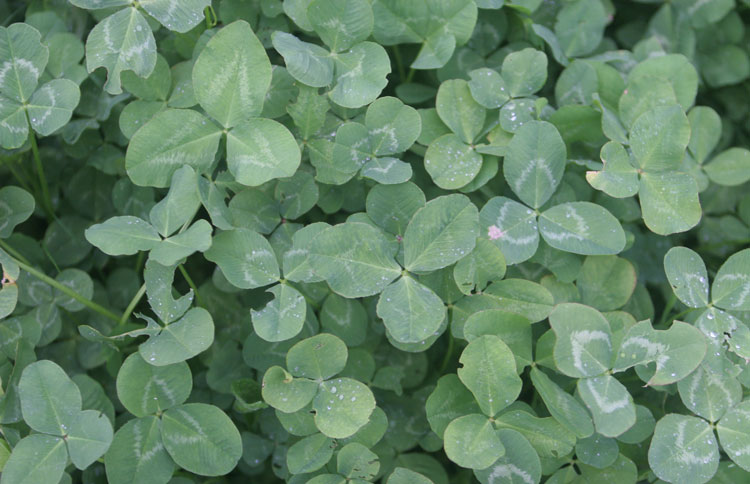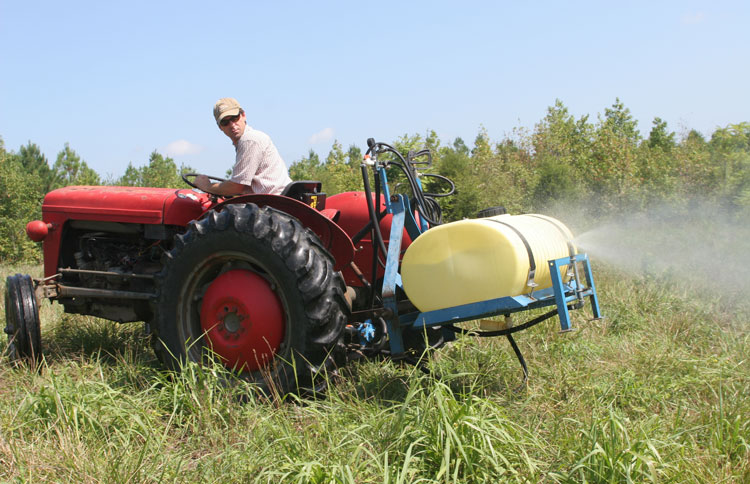You can mow, chop and even pull all the weeds your arms will allow. In the end though, nothing kills unwanted plants more effectively and more efficiently than weed-killing herbicides.
“In many situations, it’s important to get rid of as many weeds as you can,” says Biologic’s head of research and development Austin Delano. “However, it’s equally important to understand that many of the plants we call weeds are actually beneficial to wildlife. We don’t necessarily want to kill everything, unless we are starting a food plot from scratch.”
With that said, unwanted plants can overtake a food plot or any other space on your land if they are allowed to grow unchecked. That’s why herbicides can be a land manager’s most important and valuable tool.
“Weeds use up valuable resources like nutrients, water and sunlight,” said Delano. “Non-native, invasive plants can also take over the landscape if they aren’t kept under control. Kudzu is a perfect example. It will swallow up entire farms if it isn’t controlled. Some can be controlled mechanically or even by hand, but herbicides make the job a lot easier.”
Related: Here’s a Year-Round Scouting Camera Plan
Selective or Non-Selective: What’s the Difference?
The most common herbicides used by food plotters fall into two general categories: selective and non-selective. As the names imply, non-selective herbicides kill virtually every plant they touch. The most common is glyphosate, the active ingredient in Roundup. It’s a great all-purpose product for clearing ground for new food plots. It’s also ideal for spot-spraying individual plants. Ridding your land of non-native, invasive plants like tree-of-heaven, kudzu and others is nearly as simple as spraying them with a shot of glyphosate.
Selective herbicides “select” and kill certain types of plants. Clethodim, the active ingredient in Whitetail Institute’s Arrest and Biologic’s Weed Reaper, kills grasses without harming broadleaf plants like clover, sunflowers and beans. Sethoxydim is also a grass-specific herbicide. Poast is the most common brand-name herbicide with sethoxydim.
Be careful, though. Not all plants in the grass family grow only in your lawn. Corn, sorghum, wheat, oats and millet are members of the grass family. Grass-specific herbicides will kill them along with unwanted grasses like Bermuda grass and fescue.
A variety of other selective herbicides will kill nothing but broadleaf plants, while allowing the grasses to grow unharmed. They are valuable tools in oats, wheat and corn, among other grasses. Most broadleaf herbicides include the generic chemical 2,4-D.
Other selective herbicides kill most broadleaf plants except various legumes like clover, alfalfa and trefoil. They are perfect for controlling a variety of unwanted plants in clover and alfalfa food plots and they won’t harm other legumes like soybeans and trefoil. Whitetail Institute’s Slay is designed for that purpose. So is Pursuit, which uses the same active ingredient.

Certain herbicides kill most broadleaf plants, except various legumes like clover, alfalfa and trefoil. This makes them ideal for controlling various unwanted plants in clover and alfalfa food plots.
Pre-Emergents
Another variety of herbicide prevents plants from growing by inhibiting their seeds. As their name implies, pre-emergents are used to prevent the initial growth of selected plants. They won’t, however, stop plants from growing once they’ve sprouted and become established. In most instances, “established” means plants that are 3 or 4 inches tall.
Farmers use pre-emergents on a variety of crops after those crops have started to grow. Some food plotters use them as well, but they are not an option for most perennial food plot plants because the weed seeds often sprout and grow at the same time as the plot seeds.
“You really need to understand pre-emergents and their limitations before you consider using them,” says Delano. “They can be advantageous, but you need to be thinking a growing season or two down the road because the residue can remain in the soil and affect future food plot plants.”
Related: Food Plot and Land Management Products
What About Generics?
No matter what you plan to accomplish, consider using a generic herbicide. Glyphosate, for example, is the active ingredient in Roundup, which is a product of chemical giant Monsanto. Generally it’s the most expensive brand of glyphosate. The good news is that there are countless generic versions of the active ingredient and they often cost considerably less than the name brand. They accomplish the exact same result.
“Make sure you are buying the same percentage of the active ingredient,” says Delano. “The label will say what percentage of the total volume is made up of the active ingredient. They aren’t all the same, so you might think you are saving money when you are paying less for a lower percentage.”
Most other name-brand herbicides also have generic versions. In many cases, they are less expensive, too. A simple Google search can tell you what’s in the product you want to buy and how much of the active ingredient is in it. Not all farm supply stores have the herbicides you are looking for, but they are likely available through various internet dealers. Always remember, most generics have their own brand name. Pursuit, for example, includes the same active ingredient (imazethapyr) as Slay and is a suitable substitute.
Read the Label
Not sure? It’s all there in black and white. Every herbicide found in your local farm supply store or your big-box garden center has a label attached to it. It not only defines the active ingredient, but it also has everything from mixing and spraying instructions to a list of all the plants it kills. Follow those instructions.
“I used to think if the recommended amount was good, then adding more to my sprayer was even better,” says Delano. “I eventually learned I wasn’t just wasting money, I might have actually been doing more harm than good. Putting too much herbicide on the ground could make it difficult for other plants to grow. The residue left behind by some chemicals might inhibit the growth of plants in the future.”
Mixing rates are printed on the label. Not only will following the instructions ensure the most effective weed control, but it will also save you lots of money. Remember, more isn’t necessarily better. Whitetail Institute’s Slay, for example, recommends just 3 to 6 ounces of herbicide per acre of food plot. The amount depends on the growth stage of the individual weeds you want to control.
However, Delano says it’s important to mix the herbicide with an adequate amount of water to get complete plant coverage. The amount of water you mix dictates how much water/herbicide solution falls on the plant leaves. What matters most is that you apply the recommended amount of herbicide per acre, but Delano recommends 12 to 15 gallons of water per acre as a general rule.
“You want to cover as much of the leaf as possible, without putting so much liquid on the plants that the solution drips off,” he explains. “However, you don’t want to put so little water in the tank that you only get a few droplets on each leaf.”
An added surfactant or sticker will help your herbicides spread across or stick to the plant leaves and work faster and more effectively. Some herbicides, like most glyphosate products, have a surfactant already mixed in the jug. Others, like many of the grass-selective herbicides, don’t. You’ll need to add something like a crop oil concentrate to the mix. Again, follow the label.
Herbicide labels will also tell you the plants it will kill and won’t kill. It’s up to you to know your plants and every serious land manager should be well-versed on the various plant species on his land. Having a good working knowledge of the habitat not only makes you a better land manager, but it also makes you a better hunter.
Related: How to Manage Your Food Plot During a Drought

Herbicide labels will also tell you the plants it will affect. It’s up to you to know your plants.
Be Patient
If you follow the instructions, you’ve successfully killed the plants you want to kill. It might not look like it, but the chemicals are working. It just takes time. In some cases, you might not see any noticeable effects for several weeks. Grass-specific herbicides in particular are slow to show any impact.
Some glyphosate products contain another herbicide (paraquat, in many instances) that “burns” the foliage of some plants without killing the roots. It’s added primarily for show. That is, it kills the leaves quickly so it appears the entire plant is dead, even though the roots have yet to die. They will, though. Be patient.
Be Safe
The very thought of using chemicals can be a bit unsettling. A 2011 National Institutes of Health study linked the use of paraquat products to higher rates of Parkinson’s disease among farmers.
Which leads many food plotters to ask: Are herbicides safe?
“Absolutely,” says North Carolina State University extension weed science specialist Alan York. “These products go through a lengthy, rigorous series of toxicology tests, environmental tests and a whole slew of other tests that examine the safety aspects from all possibilities. Before anything can be approved by the Environmental Protection Agency and used for any application, it has to meet these sets of safety standards. Often, those safety standards are set much higher than necessary just to make sure there are no hidden dangers. If the herbicide is meant to be used on forage for dairy cows, then toxicologists will examine the milk for chemical residues to determine if there is any danger in that milk. If it’s meant to be used around poultry, then they will look for residue in eggs or in the meat itself.”
However, that doesn’t mean you should forgo any common sense. Even the safest chemicals can be harmful if ingested in unusually high amounts. They can be absorbed through the skin, too. That’s why Delano always wears chemical-resistant gloves when he’s handling herbicides. A long-sleeve shirt is part of his standard spraying uniform, as well. So are sunglasses. If he’s working with a sprayer that emits a fine mist and there’s a breeze, he might also wear a respirator. Herbicides might be perfectly safe, but why take chances?
It isn’t just his own safety he’s worried about. Delano avoids using certain herbicides around ponds and streams. Roundup, for example, is deadly to a number of amphibians. Frogs, salamanders and their offspring are vulnerable not to the glyphosate, but to a sticking agent mixed in with the herbicide. Either way, spraying Roundup on plants near water can be devastating to a pond’s ecosystem. Remember, read the label. It will provide not only safety guidelines, but also environmental risk warnings.
Scared? Don’t be. Simply use common sense and read the label again if you aren’t sure. When used properly, herbicides can be a food plotter’s best friend.
Related: Plant Professional Food Plots Every Time
Article photos: David Hart






